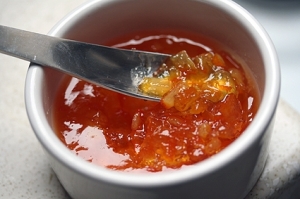Is there a better way to store fruits and vegetables? Are there better kinds or times to purchase them? Is there one preservation process that’s more nutritious than others? The answers to these questions all depends on what you are ultimately more concerned about. Taste, texture, freshness, appearance (familiarity) or nutrition. What I’m going to provide you with today is simply a rule of thumb as to the hierarchy of the condition of the fruits and vegetables to obtain in terms of nutrition and cost. Then you’ll need to decide, as always, which type really fits your family.
The first choice for most people when obtaining fruits and vegetables is to get them fresh–either they grow their own or they purchase them from the store. However, you should be aware that the nutritional content does vary dramatically dependent on what types of pesticides and other chemicals are used and WHEN the fruits and vegetables are harvested. Obviously, harvesting them at their peak time in an organic setting will be the most enjoyable and nutritious for your family. The downside to fresh produce is that you don’t know if they were harvested at the ideal time. And even if they were, how long did they travel before they got to your store? How much will you end up having to toss as a result of spoilage? These types of mostly unanswerable questions make the top dollar you pay for fresh produce a bit of a gamble. I wonder if fresh really does belong at the top of the produce hierarchy?
Having said that tough, I’m all for making my own FRESH produce by growing my own sprouts. Sprouts have significantly more nutrition in them than just about any produce you can purchase anywhere. Not only that, but they are economical and they contain no nasty chemicals. Remember, you can easily sprout any whole grain, nut, legume, or seed. (Stay away from the flowers on tomatoes and potato sprouts. They are toxic.) I can’t believe I’m saying this, but my husband actually got me hooked on having sprouts on my sandwiches instead of lettuce. In fact, at the end of this article I’ve got a GREAT Orange Marmalade Sprout Salad recipe for you. Yum!
So, if not fresh, then what’s next on the hierarchy? Freeze-dried. Not to be confused with dehydrated. Freeze-dried produce typically contains 90-95 percent of the same nutrition as picked-in-their-prime fresh produce. And there are no contaminants with freeze-dried produce. I’ve not kept it a secret that I’m in love with all of the freeze-dried fruits and vegetables that Blue Chip Foods manufacturers. They truly are my favorite. I can do just about anything with freeze-dried produce as I can with fresh. They take very little, if any, time to reconstitute. The taste packs a punch of REALISM that you wouldn’t expect. The fruit doesn’t taste soggy like frozen, defrosted fruit does and I’ve also discovered that it’s actually quite economical. I don’t end up throwing away ANY freeze-dried produce despite the fact that my hubby isn’t a veggie fan. I find myself eating the strawberries, raspberries, bananas, and peas right out of the #10 cans. Dollar for dollar, the purchase price is the SAME between fresh and freeze-dried when you get the cans at regular price—even better when they go on sale. That’s right. I can pay $35 for about the same amount of raspberries at a farmer’s market right now as I would get freeze-dried in a #10 can. Yet there will inevitably be some waste with the fresh produce. That’s just how Mother Nature works. Whereas the freeze dried product I purchase is guaranteed to maintain its nutrition, taste, and texture for a full 18 months AFTER I’ve opened the can, and for years and years when prior to opening. This is why I use the freeze-dried versions as much as possible, everyday. I use the peas in my tuna casserole, the apple slices in my apple crisp, the strawberries in an easy jam made with clear gelatin and water, etc. etc. etc. I love how I never have to cry over cutting an onion. I just open the can, scoop up the amount I need, sauté it, and I’ve got carmelized onions or whatever the recipe calls for. I never have to slice or dice peppers, spinach, mushrooms, broccoli—well, you get the point. (I AM a bit zealous when it comes to my freeze-dried produce, aren’t I? I sometimes even get goosebumps just telling people about it in my classes. Too bad you aren’t close enough to get a sample of these yummy raspberries right now.) 🙂
Next in the hierarchy are dehydrated fruits and veggies. This level of nutrition is at approximately 70-75 percent of the same nutrition as fresh produce—even when you dehydrate your own. You can enjoy dehydrated produce easily as a snack and they make easy additions to slow cooking dishes. Otherwise you need to reconstitute them and that may take a while and a bit of water. (You can also dehydrate meat successfully, but that’s another article.) When you dehydrate produce you don’t have to use your oven to do so. You can simply use the good old sunshine by itself or make use of a great solar oven. Dehydration is quite simple to do yourself, however, most dehydrated foods sold commercially are about the same cost as freeze-dried. If you have the choice, pick the freeze-dried version. Here’s a tip. When you’re rehydrating your foods, instead of using water to do so, use broth, juice, milk, or the water from the cans of other ingredients—whatever is already a part of your recipe. It will give your dish a much greater flavor. When I reconstitute apple chips, I use this yummy “Apple Delight” drink I get from Blue Chip. When reconstituting vegetables, I’ve also been known to use the water from the cans of other veggies I may be using in order to no throw any more nutrients and flavor out than necessary. I’ve also used the pasta water, potato water, etc.
Next, and definitely last in the hierarchy is canned. Canned produce keeps about 40-45 percent of the same nutrition as fresh right off the bat. Even when you do it yourself, you’re not likely to obtain more than 50 percent of the nutritional value as you would a fresh piece of produce. Obviously, the longer you store it, the more of its nutrition you lose. I personally do not can my own fruits and vegetables. Why? Because I can purchase the canned goods for a much better price than what my time and energy are worth—especially with coupons! And considering what all I get in return, in terms of nutrition, I just don’t think it’s worth the money. I’d rather pay more for the other options.
One point I do want to make. When you purchase fresh produce, such as the oversized bags of spinach at Costco, don’t hesitate to freeze it. The frozen produce is great and you don’t need to do anything special with it. Just seal it and throw it in your freezer. (The frozen spinach makes for great healthy smoothies or a lightly blanched spinach salad.) Of course you know that tomatoes, lettuce, and other high water content produce don’t freeze so well. So use your best judgment on that.
Hopefully you’ve learned a thing or two about what produce to select for your family for long and short term storage. While it may be more important that your family see something familiar at mealtime as opposed to something freeze dried, at least you can now make an educated decision.
Orange Marmalade Sprout Salad

Orange marmalade photo c/o notecook.com
Dressing:
Combine the following ingredients in a small bowl with a whisk
2 T. Orange Marmalade
4 T. Olive Oil
1 T. Balsamic Vinegar
1 pinch of red pepper flakes
Drizzle the dressing over about 4 to 6 cups of fresh sprouts of your choosing. I also like to lightly toast some nuts and put these on the salad as well. This is yummy and something you can easily make with food storage ingredients.
To see our upcoming event schedule, click here
Check out our inhome-course programs
Subscribe to Preparedness Pro today and never miss a thing!
For any questions or comments on this article, please leave a comment on the blog site so that everyone can benefit!
Copyright Protected 2009, Preparedness Pro and Kellene. All Rights Reserved. No portion of any content on this site may be duplicated, transferred, copied, or published without written permission from the author. However, you are welcome to provide a link to the content on your site or in your written works.






7 Comments
Meg from FruWiki · September 2, 2009 at 4:51 pm
Yeah, canned stuff is pretty nasty in comparison to fresh and even frozen — at least for this foodie. The texture & nutrition makes it “survival food” for me, but not much else. Then there is the added salts and other additives that are not healthy. Plus, the BPA leeches from the cans’ liners and that is NOT something I want to be eating/drinking any more of when I can help it.
I don’t think I’ve ever noticed coming across freeze-dried foods before except for that astronaut ice cream. I will have to check that out!
eggyknap · September 2, 2009 at 5:45 pm
Don’t forget fermented foods for preservation. Not every fermented food is alcoholic (in fact, most aren’t), and most are extremely nutritious, sometimes even more so than the original food. I ranted on the subject in a comment, here: http://www.utahpreppers.com/2009/06/freezing-broccoli-and-cauliflower/
Joan Hagle · September 3, 2009 at 7:13 pm
Why nothing about frozen veggies?
Kellene · September 3, 2009 at 7:18 pm
Simply because they require electricity to keep them frozen (not realistic for long term storage). However, frozen veggies are equivalent in nutrition to the freeze-dried. Just FYI. Thanks for keeping me on my toes.
Joan Hagle · September 3, 2009 at 7:21 pm
Thanks for answering so quickly.
Noelle · September 4, 2009 at 1:03 pm
Hi Kellene
I REALLY appreciated your post about vegetables–especially the freeze dried ones. I have never really considered them because they seem so expensive!! But the Blue Chip bulk ones are a pretty good deal!! I have been trying to figure out how much they cost per pound rehydrated. This is what I figured. Please tell me if I am wrong. The corn rehydrates 1 to 4 weight wise. So, if I buy 30 lb of freeze dried corn, it is like buying 120 lbs of fresh corn. If the cost is $129 (not including shipping), then the corn is a little more than a dollar a pound. The peas rehydrate at a weight of 1 to 5. So, if I buy the bulk 30 lbs, I would be buying 180 lbs of peas. So at $215ish, I would be paying $1.43 per lb. of the equivalent fresh peas. As far as the broccoli goes: it rehydrates at 1 to 13! so if I buy 11.36 bulk pounds, it would be equivalent to about 148 lbs fresh. So at a cost of $250, the price per pound would be $1.69 per pound. I called Blue chip to get the rehydrated ratios. Does that seem right? Oh, I also bought mushrooms at about $14 per #10 can. I don’t know the weight ratio of those, but if it is 1 to 10, then they would cost about $4.00 per pound. If the ratio is higher, it will be less per pound. I need to find out, but I have called Blue chip so much that I feel bad!! But I am especially excited about the mushrooms because whenever I buy them, I sometimes don’t use them in time and they go bad. Then I feel terrible that I wasted such an expensive thing. Yah for FD. My husband doesn’t like the dehydrated ones because he says they are too chewy.
Do you use freeze dried onions or dehydrated onions? I guess Blue Chip doesn’t have FD onions. I also just bought some dehyrated sweet potatoes at beprepared.com. I think they will be fun to have and use whenever. I love that Thanksgiving recipe with all the butter sugar and nuts. Now, I will not have to buy fresh or canned ones both of which are expensive!! and these will be easy to use.
Thanks again for your post. I really am excited about using these products every day instead of buying frozen vegetables. I was at such a loss about what to do because my husband does not like canned vegetables (I love my husband, but just picky!) plus they are not very nutritious. I am the Provident Living Leader in my ward, so I thank you very much for this epiphany. It is almost life changing for me since I know I will have veggies on hand and I can use them NOW.
I am planning on buying one gallon PET containers to store the bulk veggies in with an oxygen packet. What do you think about that? Do you have a better suggestion? I like the idea of being able to reuse them and getting the canner and all the cans at the cannery sounds like a nightmare.
One more thing, (sorry!!). I would like to dehydrate hamburger. The 93% stuff is on sale this week. I am planning on dehydrating it and then putting it in glass bottles and pulling the air out. I have canned it before, but I am concerned about how many nutrients it kills and I am planning on using my food storage daily, it concerns me. Do you have any experience or advise re: dehydrating hamburger vs. canning? I know they say it doesn’t last that long dehydrated, but we would not eat it before cooking it again. I would love to have an expert’s advice 🙂
Thanks for letting me ramble!!
Noelle
razr · September 12, 2009 at 1:13 am
I want to thank you…and my friend “women with guns” she turned me onto your site. I am a 67 year old woman, I live by myself in the Montana mountains…I usually “stock up” for winter….but u have shown me that I could do it much better…am now on coupon site,Blue chip Foods site…and will start rehydrating some of my own foods…I used to do it…why not again! You have given me many new things to think of and learn about….and I thank you…..lol this ole gal has a new purpose..connie
Comments are closed.